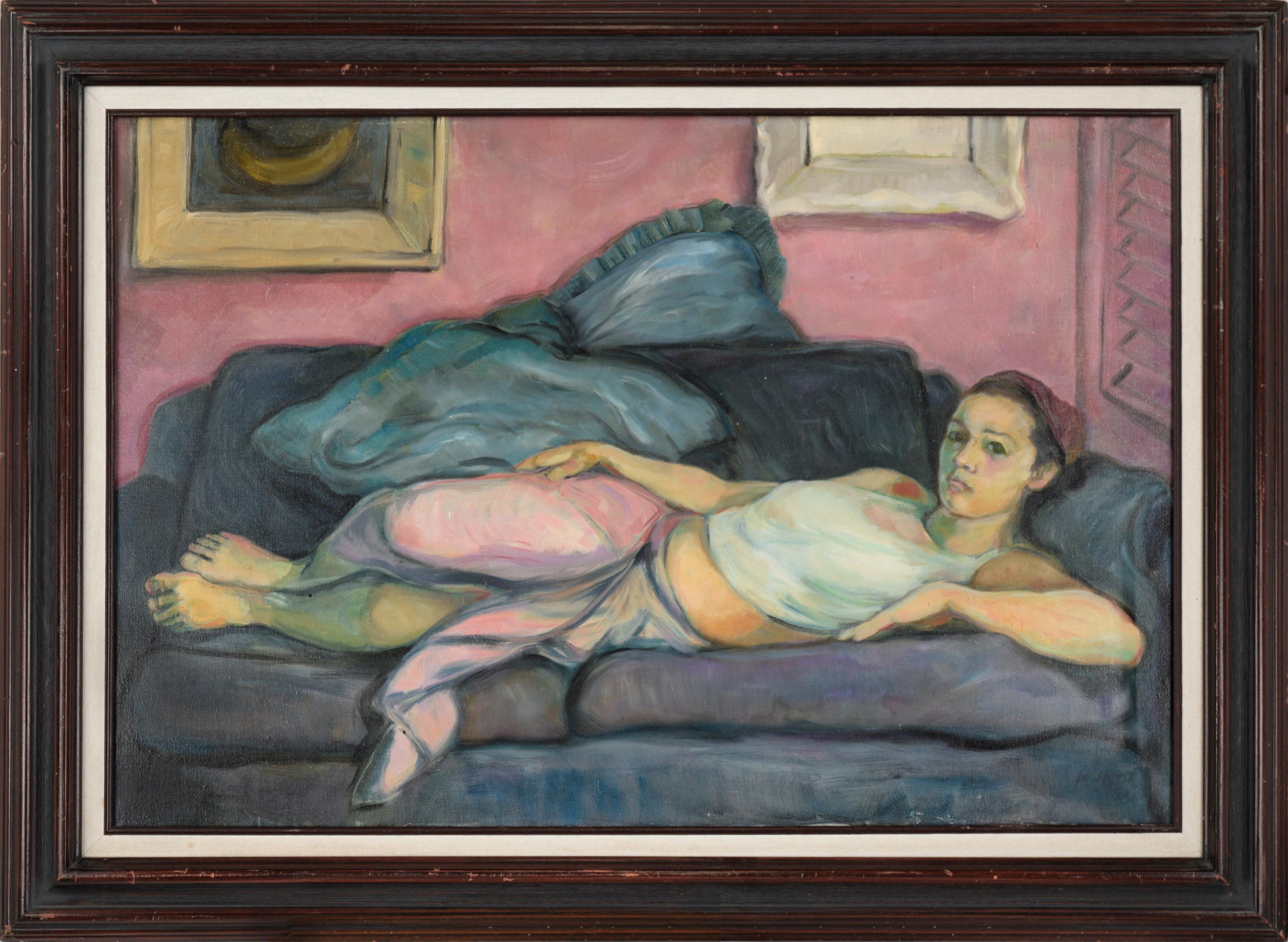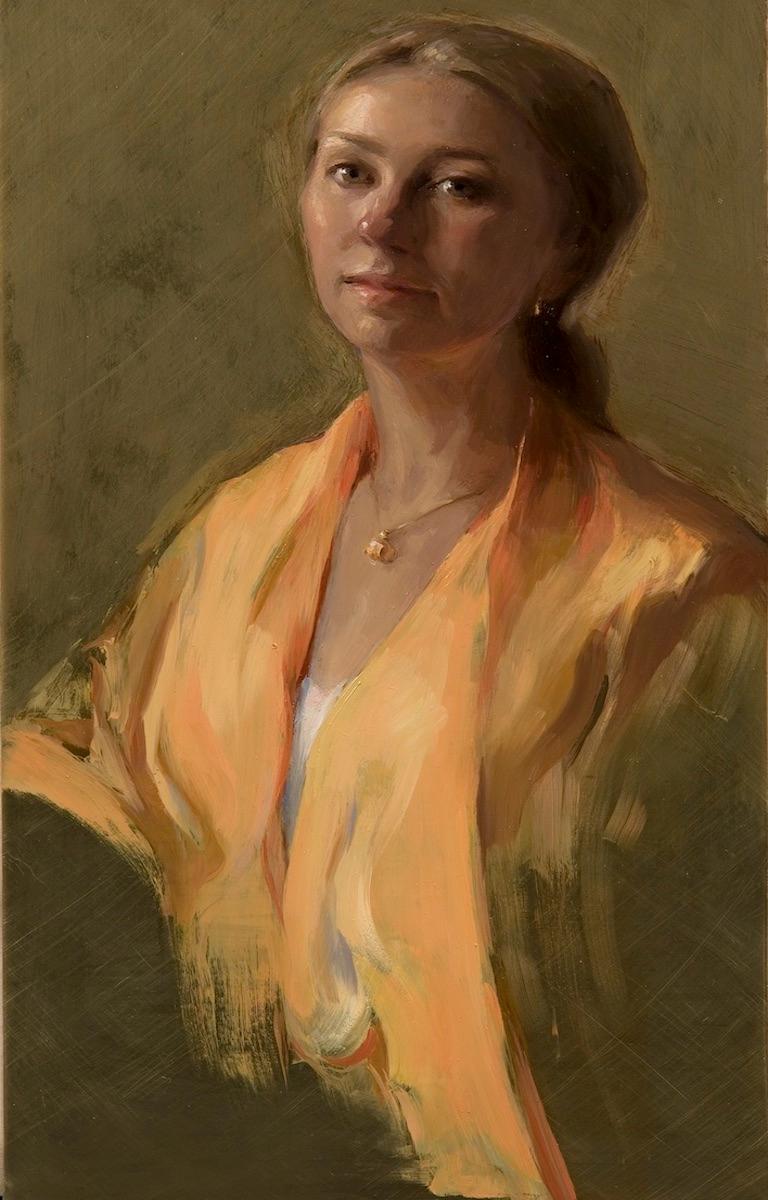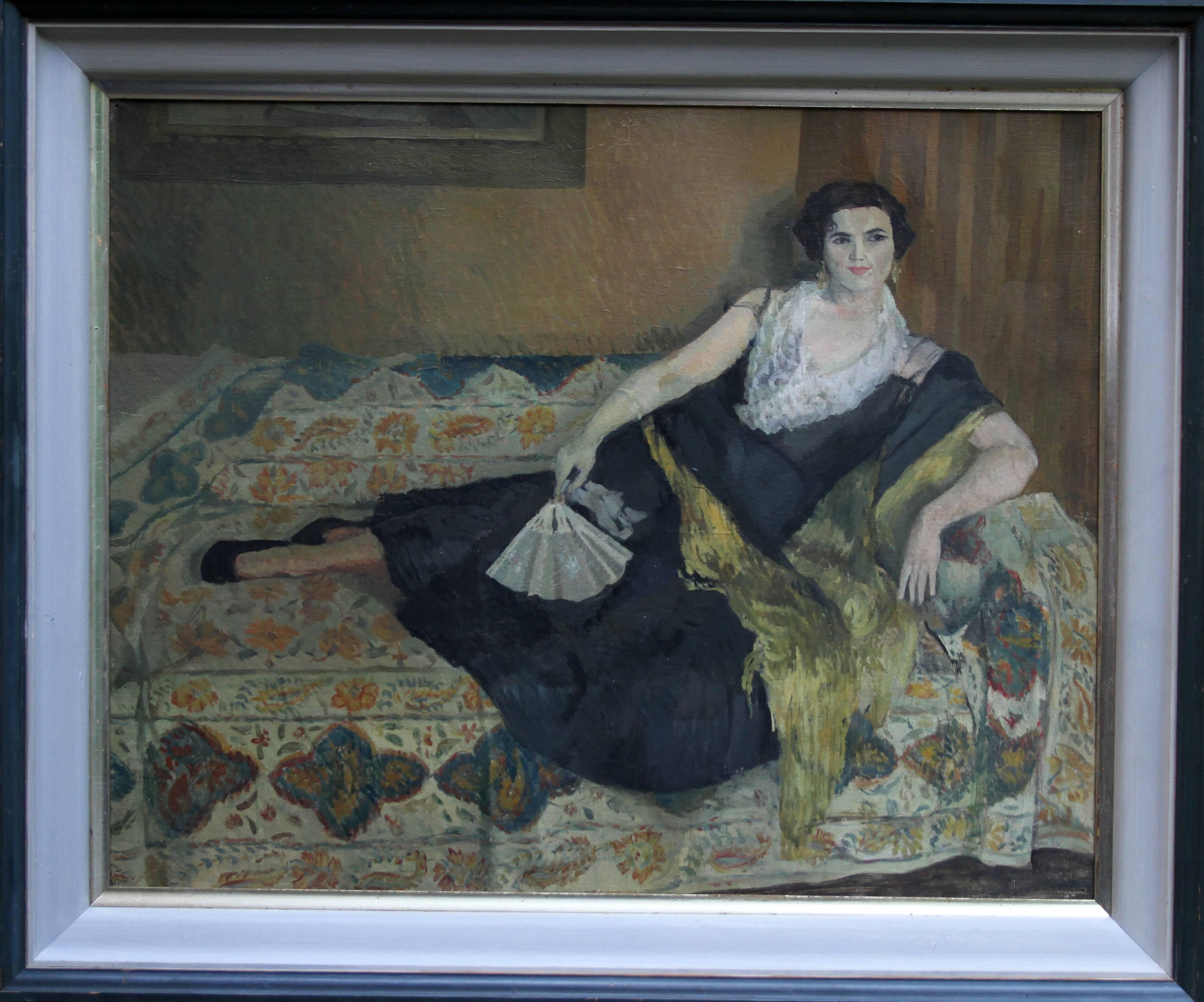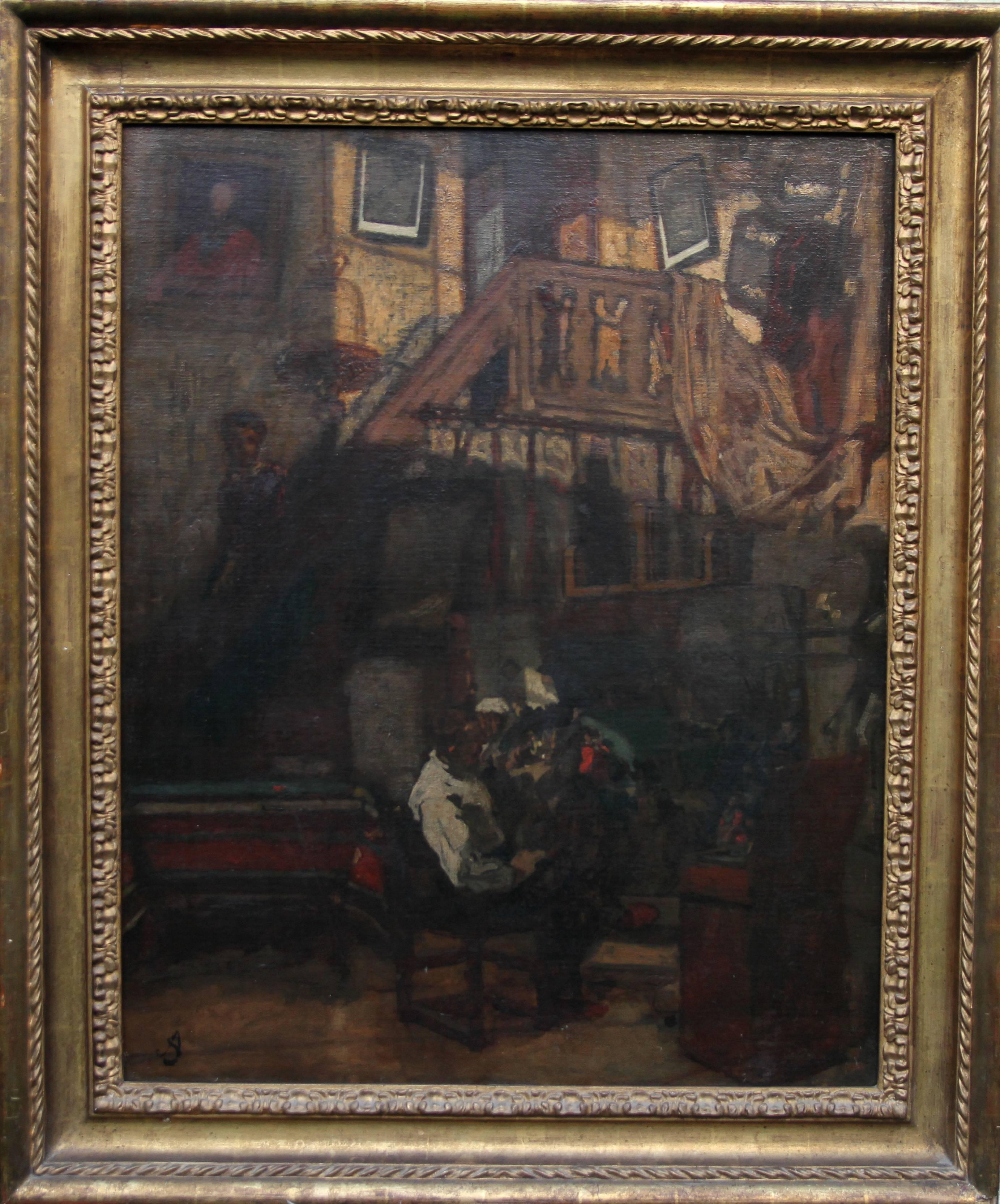Items Similar to "Tired" Portrait in Interior, Water Color on Canvas, American Impressionist
Want more images or videos?
Request additional images or videos from the seller
1 of 12
John White Alexander"Tired" Portrait in Interior, Water Color on Canvas, American Impressionistcirca 1910
circa 1910
About the Item
John White Alexander
Tired, circa 1910
Inscribed on the reverse: Mrs Lee Bauer, _____,
Inscribed on the reverse: "Tired"
Watercolor on paper
16 1/2 x 13 inches
John White Alexander moved to New York at the age of eighteen and began working as an office boy at Harper's Weekly, where he was promoted to illustrator in 1875. Two years later he enrolled at the Royal Academy in Munich, and from 1879 to 1881, he traveled and studied with Frank Duveneck in Italy. Upon returning to New York, he resumed work as an illustrator and also painted portraits. From 1881 to 1889, Alexander was an instructor of drawing at Princeton University. During this period he also traveled to North Africa, England, and many other countries. In 1890 he moved to Paris, where he exhibited with the Société Nationale des Beaux-Arts and was later elected a member. In 1895 he was commissioned to paint a mural for the Library of Congress in Washington, D.C. , and in 1905 he received a commission for a mural at the Carnegie Institute. Alexander was a member of many art associations and won numerous awards for his work, including the Lippincott Prize at the Pennsylvania Academy of the Fine Arts in 1899, the Gold Medal of Honor at the Paris Exposition Universelle in 1900, and the Medal of the First Class at the Carnegie Institute International Exhibition in 1911.
- Creator:John White Alexander (1856-1915, American)
- Creation Year:circa 1910
- Dimensions:Height: 16.5 in (41.91 cm)Width: 13 in (33.02 cm)
- More Editions & Sizes:Unique workPrice: $9,500
- Medium:
- Movement & Style:
- Period:
- Framing:Framing Options Available
- Condition:
- Gallery Location:New York, NY
- Reference Number:1stDibs: LU1841214451532
About the Seller
5.0
Platinum Seller
These expertly vetted sellers are 1stDibs' most experienced sellers and are rated highest by our customers.
Established in 2021
1stDibs seller since 2022
63 sales on 1stDibs
Typical response time: <1 hour
- ShippingRetrieving quote...Ships From: New York, NY
- Return PolicyA return for this item may be initiated within 3 days of delivery.
More From This SellerView All
- "The Letter, " Frederick Boston, Woman Reading, American Impressionism FigurativeBy Frederick James BostonLocated in New York, NYFrederick James Boston (1855 - 1932) The Letter Oil on canvas 20 x 16 inches Signed lower left The first instructor of art at the Brooklyn Institute of Arts and Sciences, Frederick ...Category
Late 19th Century American Impressionist Figurative Paintings
MaterialsCanvas, Oil
- "Marion Jones Farquhar" Frederick William Macmonnies, Tennis Olympian PortraitBy Frederick William MacMonniesLocated in New York, NYFrederick William Macmonnies Marion Jones Farquhar, 1905-11 Oil on canvas 24 x 20 inches Provenance: William Clerk Private Collection, New York Literature: Mary Smart, A Flight with Fame: The Life and Art of Frederick MacMonnies, with a Catalogue Raisonne of Sculpture and a Checklist of Paintings by E. Adina Gordon, Madison, Connecticut, 1996, no. 90. The work depicts Marion Jones Farquhar who, was an American tennis player who competed during the late 19th century and early 20th century. She won the singles titles at the 1899 and 1902 U.S championships and was the first American woman to medal at the Olympics placing Bronze in singles. Additionally, she was the artist's sister-in-law who often played and competed with MacMonnies in golf and tennis. MacMonnies would often study the movements of her form referenced in his sculpture. When MacMonnies won a doubles golf tournament he said "Marion dragged my dead weight thro' and won us the tournament, showing what great Generalship can do." A sculptor of classical figures, American-born Frederick MacMonnies had fame in the United States and Europe in the later half of the 19th century and early 20th century. He occasionally returned to America but lived most of his life as in expatriate in France. He was especially known for his lithe bronze figures, especially ones titled Diana. The classical names of these figures allowed him the appearance of propriety but gave him the opportunity to model svelte nudes. Frederick MacMonnies was one of the first American sculptors to recognize the potential market of the middle class. He copyrighted his works and then contracted with foundries to mass produce some of his figures such as Diana in smaller sizes. MacMonnies was born in Brooklyn, New York, and was a child prodigy at carving stone. At age 18, he worked in the studio of Augustus Saint-Gaudens, and then persuaded him to become his assistant, keeping models damp and covered, running errands, and cleaning the studio. Evenings he studied at the Art Students League, Cooper Union, and the National Academy of Design. In Saint-Gaudens' studio, he met many of the wealthy people who shared Saint-Gaudens Beaux-Arts based ideas that art and architecture should be unified in order to create public art in America equal to that of classical antiquity or Renaissance Europe. Among the men that MacMonnies met through Saint-Gaudens who later furthered his career were architects Stanford White and Charles McKim...Category
Early 1900s American Impressionist Portrait Paintings
MaterialsCanvas, Oil
- "The Pensive Beauty, " Carl Nordell, American Impressionism, Female PortraitBy Carl NordellLocated in New York, NYCarl Nordell (1885 - 1957) The Pensive Beauty Oil on canvas 40 x 32 inches Signed lower left Nordell was born in Copenhagen on 23 September 1885. In 1892 the Nordell family settled in Westerly, New Jersey, where Carl Johan, one of several children, received his education. Reportedly, a local gambler and art collector, Richard Canfield was so impressed with young Nordell's talent that he assisted him to gain admittance to the Rhode Island School of Design. Carl was a tireless student and serious in his studies of art, literature, and philosophy. Friends nicknamed him "The American Frans Hals," as a result of his study of that Dutch master. After graduating from the school in 1905, Nordell continued his training at the Art Students League in New York City for the following two years. There he received criticism and instruction from George Bridgman (1864-1943), a noted teacher of anatomy, and Frank Vincent DuMond (1865-1951), a landscapist associated with Old Lyme. The popularity of Impressionism in America at this time had reached its peak, and the style was of paramount influence in Nordell's advanced studies. Around 1906, Nordell visited an exhibition of paintings by the Ten, most of whom were American Impressionists. Moved by the work of Tarbell and Joseph R. De Camp, he sought instruction from them at the School of the Museum of Fine Arts, Boston. Nordell worked diligently under Tarbell and experimented with the genre of women in interiors, or Intimism. In 1909, Nordell received the Paige Traveling Scholarship, which provided for two years of continued study in Europe. He became one of the hundreds of Americans to receive criticism from Jean-Paul Laurens at the Académie Julian in Paris. From this base, he made study trips to visit major museums and galleries in Italy, Holland, Spain and Germany and during this period Nordell's style reached a level of uniqueness, though he definitely remained under the general influence of French Impressionism. By the time of his return to Boston in 1911, Nordell had successfully incorporated the use of broken color, a high-keyed palette, and the practice of working en plein air to achieve an accurate representation of light and atmosphere. In October of that year, the Boston Art Club presented eighty-seven of Nordell's watercolors and oils to the viewing public. Some of the watercolors seem revolutionary in their spontaneity. Nordell continued his career in Boston at Fenway Studios and exhibited in national competitions, including the annuals of the National Academy of Design, the Art Institute of Chicago; at the 1912 biennial of the Corcoran Gallery he won the fourth Clarke Prize. Nordell's finances were augmented by portrait commissions of some of Boston's affluent citizens. The artist was so intent on recording the sitter's likeness that in this genre, he deviated from his usual impressionist technique. In the women-in-interior genre, he frequently depicted a fully draped woman seated in profile or at an oblique angle to the picture plane. These pensive and attractive young ladies usually gaze into space and become an integral part of the pleasant ambiance of the scene. In this way, Nordell remained within the Genteel Tradition as it was manifest in Boston. The artist exhibited several such works in the Panama-Pacific International Exposition in San Francisco in 1915, and won a silver medal for his efforts. In 1918, a one-man exhibition of fifty works was presented at the Boston Art Club. Nordell remained active in the Boston area art clubs and societies through the early 1920s. In the winter of 1921 Babcock Art Galleries presented him with yet another one-man show. During this period, Nordell increased the production of prints and won the Salmagundi Club's Shaw Prize for etching in 1923. Sometime after 1927 he began taking summer sketching trips to Chautauqua Lake...Category
Early 20th Century American Impressionist Figurative Paintings
MaterialsCanvas, Oil
- "Teenagers, Coney Island" Outdoor Scene, Figures in Landscape, Beach, New YorkBy Philip ReismanLocated in New York, NYPhilip Reisman Teenagers, Coney Island Signed lower left Watercolor on paper 12 3/4 x 10 3/4 inches When he was four years old, Reisman fled Polish pogroms with his mother and thre...Category
20th Century Realist Figurative Paintings
MaterialsPaper, Watercolor
- "The Doubtful Bill" Charles Blauvelt, 19th Century Genre Painting Money InteriorLocated in New York, NYCharles Blauvelt The Doubtful Bill, 1868 Signed and dated lower left Oil on canvas 12 1/4 x 9 1/2 inches Provenance: Private Collection, Connecticut...Category
1860s Figurative Paintings
MaterialsCanvas, Oil
- "Interior of a Stable" William Hart, Hudson River School Antique, Boy and HorseBy William HartLocated in New York, NYWilliam M. Hart (1823 - 1894) Interior of a Stable Oil on canvas 17 x 12 inches Provenance William Macbeth Gallery, New York Mrs. Mabel Brady Garvan Collection Christie's New York, Sporting Art, November 28, 1995, Lot 116 Ann Carter Stonesifer, Maryland Estate of above Brunk Auctions, Asheville, North Carolina, January 27 2018, Lot 777 Exhibited New York, The Metropolitan Museum of Art, Life in America, April 24 - October 29, 1939, no. 123, illustrated. New York, Macbeth Gallery, 1892: Sixtieth Anniversary Exhibition, April 1952, p. 5, no. 18. Literature Turner Reuter Jr, Animal and Sporting Artists in America, Middleburg, Virginia, 2008, p. 306. Gary Stiles, William Hart: Catalogue Raisonné and Artistic Biography, no. 1126, illustrated. It should be noted that the Francis Patrick Garvan and Mrs. Mabel Brady Garvan collection, of which this painting was a part of, was one of the foremost American Art collections and now makes up a large part of the Smithsonian American Art Museum and the Yale University Art Gallery collections. Born in 1823 in Paisley, Scotland, William Hart emigrated with his parents to the United States at the age of nine and settled in Albany, New York. It was here that Hart first began his artistic training when he was placed under the tutelage of Messrs, Eaton & Gilbert, the prestigious coach-makers from Troy, New York. During this time, Hart learned how to decorate coach panels, covering them with either landscapes or figurative compositions. At the age of seventeen, he was eagerly contemplating an artist’s profession. Consequently, he left the mechanical trade of coach-making and began expanding his artistic pursuits to more refined endeavors. Hart followed coach-making with decorating window shades and later developed an interest in portraiture. Around 1840, he established his first formal studio in his father’s woodshed in Troy. There, he created many likenesses of individuals, affording him a nominal income. Once, he remarked that he felt prouder over his first fee of five dollars for painting a head then for the larger sums he would command later in his career. Nevertheless, his wages from portraits during this early period proved insufficient. Thus, he expanded into landscape painting, allowing him to barter his works or sell them for modest prices. In 1842, Hart moved to Michigan in an attempt to further his success; portraiture remained his primary means of support. Unfortunately, his experiences in the West were disappointing. Hart spent three years living a rough existence until he finally returned to Albany in 1845. Upon his return, he fully devoted himself to the art of landscape painting. Despite his failing health, he worked diligently to perfect his skill until 1849 when he traveled abroad to his native land of Scotland. This trip was made possible through the generosity of his patron and advisor, Dr. Ormsby of Albany. For three years, he studied in the open-air, creating brilliant sketches of the Scottish Highlands and the surrounding British Isles. Returning to Albany once more in 1852, Hart enjoyed improved health and was reinvigorated with purpose. The following year, he moved to New York and opened a studio, promoting himself as a specialist in landscape painting. Hart became a regular contributor to the National Academy of Design. His works received a great deal of attention from artists and connoisseurs alike, all of whom praised him for his fresh, self-taught style. In 1855, he was designated as an associate of the National Academy of Design; three years later he was elected to Academician. In 1865, he was unanimously chosen to be the first president of the Brooklyn Academy of Design. It was during his tenure there that he delivered his famous lecture The Field and Easel, which emphasized the distinguishing principles of landscape art in America. Hart argued that landscape painters should express the “look of the place” being depicted.Critics during the 1870s noted his sensitive balance between capturing a strict “real” interpretation of nature and that of a more “ideal” sentimental tone. For instance, in 1869, Putnam Magazine noted that Hart brought back “exquisite studies” of the surrounding Tappan...Category
19th Century Hudson River School Animal Paintings
MaterialsCanvas, Oil
You May Also Like
- Mid Century Portrait of Two Children in Traditional DressBy M. Ray StancliffLocated in Soquel, CAMid century portrait of two children, a young boy and girl in traditional dress, set in a rustic interior by M. Ray Stancliff (American, b. 1925). Si...Category
1940s American Impressionist Portrait Paintings
MaterialsCanvas, Oil, Fiberboard
- "Anna" - Portrait of a Reclining WomanLocated in Soquel, CABoldly colored portrait of a woman on a sofa by Nealon A. Mundt (American, 1939-2015). A woman is reclining on a dark blue sofa, with a pink wall in the background. The woman is wearing a white top and a pink skirt, with a red bandana on her hear. Her skin is rendered in a fauvist style, mixing bold yellows and greens with skin tones. There are paintings hanging on the wall behind the sofa. Signed and dated in the lower right corner. Titled, signed, and dated on verso. Presented in a wood frame with a linen fillet. Canvas size: 24"H x 36"W Nealon Mundt...Category
1990s American Impressionist Portrait Paintings
MaterialsCanvas, Oil
- GoldenBy Melissa Franklin SanchezLocated in Sag Harbor, NYAn impressionistic self-portrait. Franklin Sanchez leaves the edges of her brass "canvas" exposed as a golden background to her portrait. Frame Dimensions: 21.45 x 12.82 inches Ar...Category
21st Century and Contemporary Impressionist Portrait Paintings
MaterialsBrass
- Daughter Reading to Mother - British 1900 Impressionist portrait oil paintingBy Philip Wilson SteerLocated in London, GBThis most charming oil painting is attributed to the circle of noted British Impressionist artist Philip Wilson Steer. Painted circa 1900 this lovely Edwardian Impressionist paintin...Category
Early 1900s Impressionist Portrait Paintings
MaterialsOil
- Lady Reclining Portrait - British 50's Impressionist oil painting female artistBy Caroline HutchinsonLocated in London, GBThis large oil on canvas portrait was painted by Caroline Hutchinson circa 1955. It depicts a lady reclining on a sofa and is painted in an Impressionist palette and manner. A beauti...Category
1950s Impressionist Portrait Paintings
MaterialsOil
- Self Portrait in Studio - British art 19th Century interior oil paintingLocated in London, GBA fine interior oil painting which dates to circa 1870 by listed artist Alfred Stevens. It is a superb British Impressionist painting which depicts the artist in his studio in front ...Category
19th Century Impressionist Portrait Paintings
MaterialsOil
Recently Viewed
View AllMore Ways To Browse
Antique Was
Circa Interiors
Painting Antique White
Antique Medal
Antique Medalion
Antique Medals
Antique Association
Medal Exposition
Medal Of Honor
Alexander John
Antique Murals
Antique White Interior Paint
African American Antique
Royal Munich
Antique Italian Country Paintings
Antique African American Art
African Boy
John C Lee





